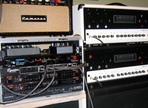
The Wet/Dry/Wet Technique
Improve your sound when using time-based effects in your guitar setup

 Print
Print |
The Wet/Dry/Wet Technique |
 |
| By FloSon on 10/19/2014 |  Print Print |
|
The idea behind this technique is to separate the dry signal (without effects) from the wet signal (with effects) so that they don't interfere with each other, while preserving the maximum presence.
This way you will be able to use your favorite amp to color the overall sound, while delegating sound spatialization to one or more other amps, which can be mono or stereo. But don't worry, there's no need to get a loan on your house, because the wet signals don't need additional coloration: Two small combos with decent speakers (or even two simulators like SansAmp) will do the trick. More precisely, wet/dry/wet refers to the use of three speakers each with a different signal, ideally with a dry center channel, as you can see in the diagram to the left.
If you use a passive splitter for this setup, the loss of signal will be quite significant. To avoid that, use an active splitter, like the JHS Buffered Splitter or the Palmer Y-Box. The latter has the advantage of being battery-powered, which spares you all electricity-related issues, however, the cost is somewhat hefty for such a simple box.
But let's go back to the topic at hand: Plug your guitar into your favorite amp and connect the input of the splitter to the send of the effects insert. Now, take the output of the splitter and connect it to the amp's return to get the dry signal and connect the effect you want to split to the second branch of the Y. Then use the effect's stereo output to send it to the loop returns of your left and right amps. The final result will certainly be better if your pedal has a dry/wet knob to send as wet a signal as possible to both lateral amps.
You can even go so far as to assign an amp to the reverb and the other one to a delay, or a short delay to the first amp and a long echo to the second one. Or maybe you could use a pitch shifter (set just slightly above and below the target to make the sound fatter or to get majestic harmonies), a phaser, a chorus, a flanger, a volume pedal —while always having a dry sound with as much quality and definition as possible.
There are also pedals that feature two outputs, a dry and a wet one. However, the result seems more like a "dual mono" than a true stereo. Plus, don't forget that you'd need to be in possession of two good amps to really profit from it.
So, with a good amp and two small "satellite" amps ─ or just one with a stereo loop ─ you can add so much presence to your sound that you will be able to significantly lower the overall volume (despite the drummer, who certainly won't have the slightest intention of hitting the drums softer so that you can hear the vintage repetitions of your favorite delay).
To finish, and as always, don't forget to tell us about your own experiences in the comments below!
Reproduction and distribution rights reserved © Audiofanzine 2024.
For personal use only. The user of the site acknowledges that he has read and accepts the general terms of use and that he will respect them.